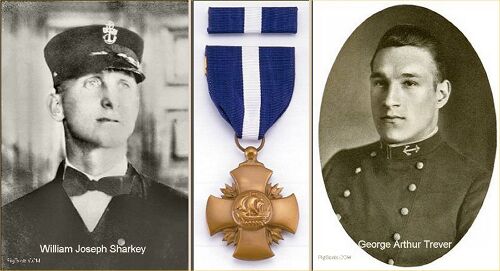Sharkey and Trever

William Joseph Sharkey was born in Auburn, N.Y., on March 20, 1885. He attained the enlisted rate of Chief Gunners Mate during his naval service, he was subsequently appointed to the rank of Ensign on March 15, 1918 and was assigned to the submarine O-5. He was later promoted to LTjg while aboard the submarine. On October 5, 1918 Sharkey died trying to prevent a battery explosion after fumes were reported in the after battery room.
Sharkey and the Captain, LCDR George A. Trever, were proceeding into the compartment just as the battery exploded from a build up of hydrogen gas. Sharkey was posthumously awarded the Navy Cross, on the recommendation of CDR Chester W. Nimitz, who was a friend of Sharkey's.

The destroyer USS Sharkey (DD-281) was named in his honor, the ships sponsor was Mrs. Mary E. Sharkey.
Also, at the Naval Submarine Base, Pearl Harbor, a theater was named in honor of Sharkey. It is believed that CDR (later Fleet Adm.) Chester W. Nimitz, the first commanding officer of Pearl Harbor Naval Submarine Base, named the theater in honor of his friend William Sharkey.
Navy Cross Awarded posthumously for actions during the World War I:
The President of the United States of America takes pride in presenting the Navy Cross (Posthumously) to Lieutenant, Junior Grade William Joseph Sharkey, United States Navy, for exceptionally meritorious and distinguished service on board the U.S.S. O-5, at the Navy Yard, New York 6 October 1918. Lieutenant Junior Grade Sharkey called the attention of his Commanding Officer to the fact that the batteries were gassing, and together with his Commanding Officer started forward in the submarine when the battery exploded and Lieutenant Junior Grade Sharkey was killed, his head being crushed.
A native of Waupun, WI, George Arthur Trever received an appointment to the U.S. Naval Academy in May 1905, graduating on June 4, 1909. As was typical of officers at the time, he served on several surface ships in his early career, including early command of the surface torpedo boats USS Rowan (Torpedo Boat No. 8) and Farragut (Torpedo Boat No. 11).
After another surface ship tour, he transferred to submarines and qualified aboard the USS H-1 (Submarine No. 28). He also served aboard the N-1 (Submarine No. 53). His next assignment, his first as a submarine commanding officer, was the O-5 (Submarine No. 66), under construction at the Fore River Shipbuilding Company in Massachusetts. Upon assuming command, he was promoted to the rank of Lieutenant Commander.
On October 5, 1918, during a post-commissioning refit, Trever was severely injured while trying to prevent a battery explosion aboard the O-5, which killed LTjg William Sharkey. Nine days later, while recuperating at the Naval Hospital Brooklyn, NY., Trever died of his injuries.
Navy Cross Awarded for actions during the World War I:
The President of the United States of America takes pleasure in presenting the Navy Cross to Lieutenant Commander George Arthur Trever, United States Navy, for distinguished service in the line of his profession as Commanding Officer of the U.S.S. 0-5, operating against enemy submarines off the Atlantic coast of the United States during World War I.
Partial information provided by Sharkey's grandson Douglas Chartier.
Page created by:
Ric Hedman & David Johnston
1999 - 2023 - PigBoats.COM©
Mountlake Terrace, WA, Norfolk, VA
webmaster at pigboats dot com
